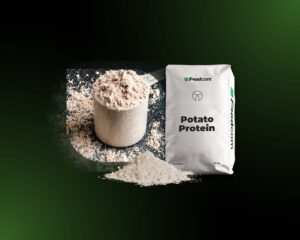- The booming market for potato protein and other plant-based nutrients is responding to growing demand.
- Supply shortages and rising prices for sweeteners such as maltitol and sorbitol underline the need to find new sources and alternatives.
- The price of cocoa has reached a historic level of USD 10,000 per ton, heralding changes in chocolate prices and challenges for producers in the face of limited supply.
Hello partners,
Are you ready for the freshest news from Plant-based Industry?
In the face of growing global challenges in food production and changing consumer preferences, the market for plant-based products – including proteins, starches, sweeteners, and cocoa – is undergoing a period of intense change. From increased interest in potato proteins, to the booming sugar-free sweetener segment, and also record prices for cocoa, the food industry must adapt to new realities. These trends, which highlight the growing demand for plant-based alternatives, and the challenges of producing traditional raw materials, paint a picture of an industry at a crucial time when producers and consumers are looking for sustainable and healthy options against a backdrop of global climate and economic change.
Products of the Week
Proteins
The growing interest in Potato Protein for feed has led to a steady increase in demand for potatoes as a raw material. This phenomenon is exacerbated by the limited supply of potatoes, especially as it will be many months before the new harvest. Producers and suppliers of Potato Protein are faced with the challenge of meeting the increasing demand, which underlines the urgent need to increase future production and harvesting efficiency. Corn Gluten Meal is seeing similar demand and the product is increasingly more expensive and more difficult to find.
In addition, plant proteins have become an important component of nutritional supplements for athletes and physically active people looking for healthy and balanced energy sources. From peas, to soybeans, and chia seeds, the variety of plant-based protein sources available is growing in line with market demand.
We are seeing a rapid increase in orders for texturized products made from soy and peas, which are mainly used for vegan chops. The growing interest in plant-based diets is leading to greater demand for these meat alternatives that try to mimic the texture and taste of traditional meat. Manufacturers are responding to these changes by developing new products to meet the growing expectations of consumers seeking high-quality plant-based alternatives. These alternatives are available in nuggets, ground, or filets and can be made from wheat, pea, or soy.
Starches
The Starch market is currently experiencing interesting trends due to growing global demand in the food, pharmaceutical and biodegradable packaging sectors. Despite this optimism, forecasts for future harvests suggest possible shortages that could upset the balance between supply and demand.
In the case of Corn Starch, the market panorama appears to be even more complicated. Experts are predicting a steady decline in the price of this raw material on the global market, which seems to contradict the general trend of rising demand for starch. The reason for this is the large supply of corn, especially in China, where people are cautious about placing new orders. This increased supply, together with developments in other major producing regions such as India, Europe and the USA, is contributing to lower cornstarch prices.
Sweeteners
The sweetener market is facing interesting challenges. Demand for traditional Sugar remains stable, although experts predict that prices could rise in the near future if Ukrainian supply is blocked.
In the sugar-free sweetener segment, the shortage of Maltitol and Sorbitol has now become a major challenge. The limited quantities of these substances are due to rising global demand, particularly in the food and pharmaceutical industries, which exceeds current production capacities. This in turn is driving up prices and the search for alternative sources of sweeteners.
The price of Dextrose, a popular plant-based sweetener, has also risen. This is the result of increased demand for products based on natural ingredients and for functional sweeteners that offer additional health benefits beyond pure sweetening. The prices of raw materials such as corn starch, from which dextrose is made, have a direct impact on the cost of sweetener production.
Cocoa
According to Bloomberg, rising Cocoa prices have exceeded the USD 10,000 per ton mark for the first time in history. The price rose by 4.5% to a record high of USD 10,080 per ton recorded on March 26. The main reasons for the increase are low yields in the West African countries, the most important cocoa producers, and pressure on the financial markets. In addition, the entry into force of new EU regulations on deforestation could further reduce the supply of cocoa for EU chocolate manufacturers. A 60% increase in cocoa prices in March alone and more than a doubling since the beginning of the year is making the situation in the industry more difficult. Such a situation will certainly cause chocolate prices to rise in the near future.
What else?
The EU is considering extending duty-free trade with Ukraine for another year. However, some member states are pushing for the safeguard measures to be extended to other Ukrainian agricultural products such as oats, maize, grain and honey. They are also proposing to shorten the activation period for safeguard measures from 21 to 14 days and to introduce stricter controls on imports of cereals and sunflowers. Discussions are still ongoing and a final decision is expected soon.
Iowa, a leading corn producer in the U.S., begins the seeding season with one of the driest periods on record. The drought is accelerating seeding and could depress grain prices. Despite a possible improvement thanks to rainfall in the spring, forecasts show an increased risk of drought for the summer. The water restrictions are forcing farmers to change cultivation, which could have an impact on yields. February 2024 was the warmest month since records began, continuing the global trend of record temperatures.
In Italy, the EU’s largest soybean producer, the area under oilseed cultivation increased by 6% in 2023 compared to 2015 and has reached record levels in the last two seasons. The area planted to soybeans, sunflowers and rapeseed has increased, with soybeans accounting for almost 70% of the country’s total oilseed crop. Despite continued EU demand for soybeans as a protein feed, Italian production faces challenges such as drought and heat, especially in the south, making production increasingly dependent on irrigation. Italy also imports significant quantities of oilseeds and vegetable oils to meet domestic demand.








